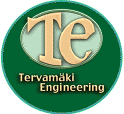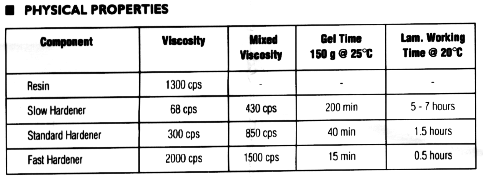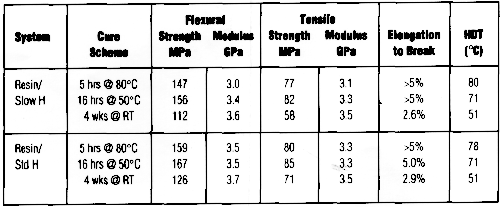| [Home | Experimental Aircraft | JT-5 Autogyro |3D Modeling ] | ||
This information is included here for those who have not used epoxy resins and may not know the techniques required. It should be noted that, in contrast to polyesters, epoxies require a very exact mixing ratio. | ||
| SP Ampreg 20TM Epoxy Laminating System
· FEATURES · Good mechanical properties
· INTRODUCTION SP Ampreg 20 is one of the new generation of wet lay up laminating resins designed by SP. Systems tormulated without DDM (MDA) or phenol. This significant improvement in the health and salety aspect has been achieved without detrimental eflects to the mechanical properties. The SP Ampreg 20 laminating system has been developed specifically tor the manutacture of highstrength lightweightcompositeswithglass aramid or carbon fibres by wet lay-up techniques. The low initial viscosity allows laminates to be produced by contact pressure vacuum or pressure bag techniques filament winding or vacuum assisted resin injection. Thorough wetting of reinlorcement fibres is ensured by the low viscosity and excellent air release properties of the resin/hardener mixture This in particular assists with the impregnation of aramid and carbon fibres. SP Ampreg 20 exhibits good mechanical properties with an ambient temperature cure. However a post cure can be utilised to produce optimum properties from the resin system.
· TECHNICAL DATA SP Ampreg 20 resin is combined with SP Ampreg 20 fast, standard or slow hardeners in the following ratio: Resin: Hardener 100: 25 (byweight) 100: 29 (volume)
· SP AMPREG PREGEL Ampreg Pregel is a thixotropic resin modilier that can be used with Ampreg 20 hardeners It must be mixed with the chosen Ampreg 20 hardener at a ratio of 100:25 byweight.It can be used in the tollowing situations: · As a resin modifier to reduce drainage in laminates. For more intormation please see the separate data sheet · VACUUM BAG TECHNIQUES Consolidation ol the laminate can be obtained either by hand using paddle rollers or by vacuum or pressure bags. It is important when using high vacuums and using the slower hardeners that vacuum is no tapplied until at least 5O% into the laminate working time as excessive flow and resin starved laminates may result. Heating can be economically and eflectively achieved with either space heaters under an insulation tent or heated blankets with insulation over. Details ot the various types ol system are available from SP Systems Technical Services.
· BONDING TECHNIQUES & CORE MATERIALS Where it is necessary for a bonding operation to be carried out following the cure ot the Ampreg 20 laminate Peel Ply (DP100) can be applied to the surtace to be bonded during the layup process. After curing and just prior to bonding the Peel Ply is stripped of leaving a clean dust and grease free textured surtace which does not need further preparation before bonding. Trials may be required to test Peel Ply suitability. Various core materials can be used with the Ampreg 20 system, including PVC and other foams, honeycombs and endgrain balsa as well as more specialised cores Contact SP SystemsTechnicalServiceslorturtherintormation Ambient Temperature Cure - Ampreg 20 has been developed to return good mechanical properties after cure at ambient temperatures the minimum recommended temperature being 18°C and excellent properties after a slightly elevated temperature postcure. An initial cure ot at least 48 hours (with slow hardener) or 16 hours (with fast hardener) at 18°C is recommended belore de-mouldinq. Laminates subjected to an ambient temperature cure should be allowed 14 days betore the system can be considered to be adequately cured and should be kept in a warm dry environment during this period. When using the slow hardener exclusively, an elevated temperature cure is strongly recommended. Elevated Temperature Cure - Post curing the laminate will greatly increase mechanica properties as shown in Table 1 (see Technical Data) The Ampreg 20 system will achieve similar properties with a cure of either 5 hours at 80°C or l6 hours at 50°C but as the table shows the cure has been optimised for 50°C. The latter temperatures are easily achievable with low cost heating and insulation techniques The table below shows that these cure cycles improve the properties by up to 60%. There is a considerable increase in glass transition temperature and toughness of the system with the elongation at break increasing to approximately 6.5%. The post cure need not be carriedoutimmediately after laminating and it is possible to assemble several composite components and postcure the entire assembly together It is recommended however that elevated temperature curing should be completed before any final painting/finishing operations. Furthermore, care shoud be taken to adequately support the laminate if it is to be postcured after demoulding and the laminate must be allowed to cool betore the support is removed.
· SP AMPREG ULTRA SLOW HARDENER A separate data sheet lor Ampreg UltraSlow Hardener is available. This hardener gives an extended working time (8-10 hours) and is used at a diHerent mix ratio (100:30 by weight) than the other Ampreg 20 hardeners. Details of the postcure schedules required are given in the separate data sheet available for this product.
· HEALTH & SAFETY The folowing points must be considered: 1. Skin contact must be avoided by wearing disposable rubber gloves. The use ol barrier creams is also recommended. 2. Care must be taken to avoid the risk of splashing resin or hardener into eyes If this occurs the eye should be immediately well flushed with water for 15 minutes and medical advice sought. 3. The inhalation of sanding dust should be avoided and, in particular care should be taken not to rub the eye area when exposed to sand ng dust. After any sanding operation of reasonable size a shower or bath should be taken and should include hair washing. 4. Overalls or other protective cIothing shouId be worn when laminating or sanding. Contaminated work clothes should be thoroughly cleaned before reuse. 5. Any areas of skin coming into contact with resin and hardener must be thoroughly cleansed. This should be achieved by the use ot resin removing creams and washing with soap and water. Solvents should not be used on the skin.
This cleaning should be routine: · betore eating or drinking
6. Ensure adequate ventilation and avoid excessive contact with solvent vapours which may cause dizziness and headaches.
· TRANSPORT & STORAGE The resin and hardeners should be kept in securely closed containers during transport and storage. Any accidental spillage should be soaked up with sand sawdust cotton waste orany other absorbent material The area should then be washed clean (see appropriate Safety Data Sheet) Adequate long term storage conditions for both materials will result in shelflives of two years for both the resin the hardeners. Ideally storage should be in a warm dry place out of direct sunlight and protected trom frost. The temperature should be between 15°C and 30°C. Containers should be firmly closed. Hardeners in particular will suffer serious degradation if left exposed to air. SP Systems produces a separate full Materials Saety Data Sheet for this product covering usage, transport, storage and emergencies. Please ensure that you have the correct MSDS's to hand for the materials you are using beore commencing work.
NOTICE The policy of SP Systems is one of continual development and improvement. Therefore the right is reserved to alter specitcations and prices without prior notice. Any information or advice contained in this publication or obtained from SP Systems by other means and whether relating to SP Systems materials or other materials is given in good faith. However it remains at all times the responsibility of the customer to ensure that SP Systems materials are suitable for the particular process used and purpose in tended. SP Systems therelore strongly recommend that representative test panels and component sections are built and tested by the user in order to define the best process and materials to use tor the desired component This should be done under conditions as close as possible to those that will be used on the final component. SP Systems data sheets are being continuously reviewed and updated. Please ensure that you have the current version betore using the product by contacting SP Systems Marketing Services and quoting the revision number in the bottom right hand corner ot this page.
Structural Pollymer Systems Limited Rev: UKAMPREG20-8-1096
| ||
| Questions and
answers [Home | Experimental Aircraft | JT-5 Autogyro |3D Modeling ] |


